
Debt-Free Living: Strategies for Eliminating Debt
Debt can be a heavy burden that impacts not only your financial health but also your mental well-being. It limits your ability to save for the future, invest in opportunities, and enjoy financial freedom. While paying off debt can seem overwhelming, adopting the right strategies can help you eliminate it effectively and move toward a debt-free life.
Here’s a guide to practical steps and habits you can implement to tackle debt and achieve financial stability.
- Understand Your Debt
The first step to eliminating debt is to gain a clear understanding of your financial situation.
List All Your Debts
Create a detailed list of all your debts, including credit card balances, personal loans, student loans, and any other obligations. Note the outstanding amounts, interest rates, and monthly payments for each.
Analyze Your Spending
Review your expenses to identify areas where you can cut back. Understanding where your money goes each month will help you free up funds to pay off debt. - Create a Budget
A budget is a powerful tool that allows you to manage your money effectively.
Set Clear Goals
Determine how much money you can allocate toward debt repayment each month while still covering essential expenses like rent, utilities, and groceries.
Track Your Spending
Monitor your expenses to ensure you’re sticking to your budget. Use apps or spreadsheets to make tracking easier and more accurate. - Choose a Debt Repayment Strategy
There are several proven strategies for paying off debt. Choose the one that best fits your financial situation and goals.
Snowball Method
Focus on paying off your smallest debt first while making minimum payments on others. Once the smallest debt is paid off, use the freed-up money to tackle the next smallest debt. This method provides quick wins and keeps you motivated.
Avalanche Method
Prioritize paying off debts with the highest interest rates first. This approach minimizes the amount of interest you pay over time, saving you money in the long run. - Consolidate Your Debt
Debt consolidation involves combining multiple debts into a single loan or payment.
Benefits of Debt Consolidation
Simplifies your payments by combining them into one.
May lower your interest rate, reducing the overall cost of your debt.
Options for Consolidation
Consider options like personal loans, balance transfer credit cards, or home equity loans to consolidate debt. Ensure that the new loan offers better terms than your existing debts. - Negotiate with Creditors
Many creditors are willing to work with borrowers who are struggling to make payments.
Request Lower Interest Rates
Contact your creditors to ask for a reduced interest rate. Lower rates can help you pay off debt faster by decreasing the amount of interest you owe.
Explore Payment Plans
Some creditors offer hardship programs or customized payment plans to help you stay on track. - Avoid Accumulating New Debt
While paying off existing debt, it’s essential to avoid adding new obligations.
Limit Credit Card Use
Stop using credit cards for non-essential purchases. Rely on cash or debit cards to control spending.
Build an Emergency Fund
Having a financial cushion can prevent you from relying on credit cards during unexpected expenses. Start small and gradually build up your emergency fund. - Increase Your Income
Boosting your income can accelerate your debt repayment efforts.
Take on a Side Hustle
Consider freelancing, gig work, or part-time jobs to earn extra money.
Sell Unnecessary Items
Declutter your home and sell items you no longer need. Use the proceeds to pay off debt.
Ask for a Raise
If you’re performing well at your job, consider requesting a salary increase. Even a small raise can make a significant difference in your debt repayment plan. - Make Extra Payments
Making additional payments toward your debt can significantly reduce the time it takes to become debt-free.
Apply Windfalls
Use tax refunds, bonuses, or any unexpected money to pay down debt.
Make Biweekly Payments
Instead of making one monthly payment, split it into two smaller biweekly payments. This approach can help you pay off your debt faster and reduce interest charges. - Stay Motivated
Staying motivated during your debt repayment journey is key to reaching your goals.
Track Your Progress
Celebrate small victories as you pay off each debt. Seeing your progress can keep you motivated.
Visualize Your Debt-Free Life
Think about the freedom and opportunities that come with being debt-free. Use this vision to stay focused on your goals.
Living debt-free is a realistic goal that can transform your financial future. By creating a plan, sticking to a budget, and adopting disciplined habits, you can eliminate debt and enjoy the peace of mind that comes with financial freedom.